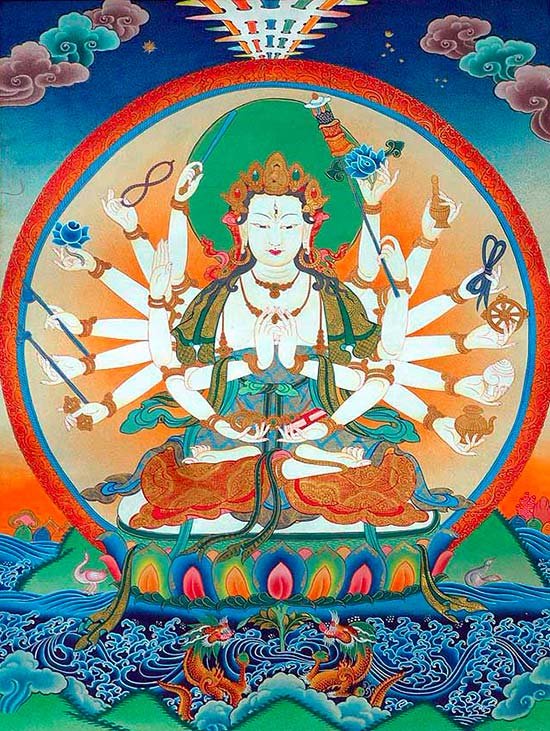Maha Prajnaparamita Sastra
by Gelongma Karma Migme Chödrön | 2001 | 941,039 words
This page describes “preliminary note (5)” as written by Nagarjuna in his Maha-prajnaparamita-sastra (lit. “the treatise on the great virtue of wisdom”) in the 2nd century. This book, written in five volumes, represents an encyclopedia on Buddhism as well as a commentary on the Pancavimsatisahasrika Prajnaparamita.
Buddhas of the present: Preliminary note (5)
The debate between the rationalists and the mystics was centered around three texts which were among the first to be translated into Chinese.
Under the Later Han (25–220 AD), the Yue-tche Tche Leou-kia-tch’an (Lokakṣema) at Lo-Yang translated the three following sūtras:
1) Aṣṭasāhasrikā Prajñāpāramitā (T 224) in 10 kiuan and 30 chapters, 179 AD.
2) Pratyutpannasamādhisūtra (T 418) in 3 kiuan and 16 chapters, 179 AD. – Another version of the Pratyutpannasamādhisūtra (T 417) in one kiuan and not dated is also attributed to Lokakṣema: it is probably an extract made of T 418.
3) Śūraṃgamasamādhisūtra, translation made in 186 AD but which has not come down to us.
These translations are authenticated by ancient colophons reproduced in the Chinese catalogues. See Śūraṅgamasamādhi, French transl., 1965, p. 67–72.
The Pañcaviṃśati Prajñāpāramitā which, as we have just seen, deals with the vision of the Buddha, was the object of two translations under the Western Tsin (265–316 AD),:
1) T 222, incomplete, in 10 kiuan and 27 chapters only, made by Dharmarakṣa in 286.
2) T 221, in 20 kiuan and 90 chapters, finished in 291 by Mokṣala. From the end of the 3rd century, these texts along with many others were the object of new Chinese translations, each time marking notable progress over the preceding ones. On the historical and socio-cultural circumstances under which this huge work was effected, see P. Demiéville, Inde Classique, II, 1953, p. 398–463; Yogācārabhūmi de Saṅgharakṣa, in BEFEO, XLIV, 1954, p. 339–430; Pénétration du Bouddhisme dans la tradition philosophique chinoise, in Cahiers d’histoire mondiale, III, 1956, p. 19–38; Bouddhisme chinois, in Histoire des religions (Encyclopédie de la Pléiade), I, 1970, p. 1249–1319; E. Zürcher, Buddhist Conquest of China, 1956, p. 35–36 (Lokakṣema), p. 63–64 (translation of the 25,000 P. P.); H. Nakamura, Survey of Mahāyāna Buddhism, in Jour. of Intercultural Studies, III, 1976, p. 60–139 where the recent voluminous Japanese studies are reviewed.
Houei-yuan (334–417), a native of Yen men in northern China, had fled the barbarian invasions and taken refuge in the Blue River Basin under the protection of the Eastern Tsin (317–420). About 380, in imitation of the Taoist ‘Immortals’, he went into retreat in the mountains and stayed at Lou-chan, south of the middle Blue River. There he lived until his death, surrounded by a community of monks and lay people who were practicing the cult of Amita, Buddha of the West. On September 11, 402, this community formed an organization and its members took the oath to be reborn together in Amita’s paradise. For this association which later formed the sect of the White Lotus, see P. Demiéville, Yogācārabhūmi, p. 357–359; E. Zürcher, Conquest of China, I, p. 219–222.
The association, in which the lay people numbered 123, swore to collectively win the pure land of Amita and, in order to attain this goal, they practiced the Buddhānusmṛtisamādhi ‘concentration of recollection of the Buddhas’. This was a meditation somewhat different from the simple recollection of the Buddhas (buddhānusmṛti) recommended in the canonical scriptures and which the Traité fully described above (p. 1340–1361F). An intense meditation, very close to an autosuggestion, caused, at the first opportunity, a direct vision of the Buddhas of the present and more particularly of the Buddha of the West, Amita. Among the disciples of Houei-yuan who engaged in this practice were Lieou Tch’eng-tche, Seng-tsi and Houei-yong. “Hardly had he first concentrated his mind sitting in dhyāna for half a year than he saw the Buddha in samādhi; when he came across an icon along the path, the Buddha appeared in the sky and lit up sky and earth where all became the color of gold: or else, spreading out his kāṣāya, he bathed in the pool of jewels. Having come out of samādhi, he invited the monks to recite sūtras” (T 2103, k. 27, p. 304b8–11; transl. Demiéville, Yogācārabhūmi, p. 358). The sūtras that inspired the association show a certain eclecticism in which the Saddharmapuṇḍarīka, the Sukhāvativyūha appeared and, above all, the Pratyutpannasamādhi.
In his preface to a collection of poetry on the Buddhānusmṛtisamādhi published by a member of the association, Houei-yuan declares: “The samādhis are very numerous, but in the strength of its merits and ease of access, that of the Buddhānusmṛti is foremost” (T 2103, k. 30, p. 351b21).
However, Houei-yuan finally had some doubts. If, he asked, the Pratyutpannasamādhi is like a dream, the Buddha seen in this samādhi, is he not a simple inner product, an aspect of our consciousness? If so, what value does such a vision have?
This is the question he asked Kumārajīva in his exchange of correspondence with the Koutchean master later in the year 406: cf. Kieou-mo-lo-che fa cha yi, T 1856, k. 2, p. 134b4–21. He could not have addressed a better authority.
For this correspondence, see R. G. Wagner, Die Fragen Hui-yüans an Kumārajīva, 1973.
